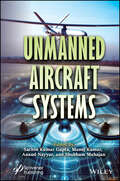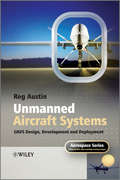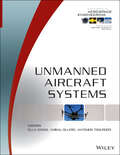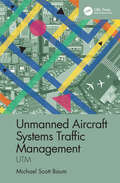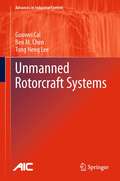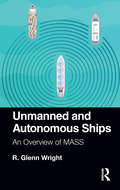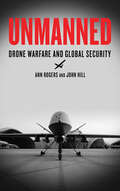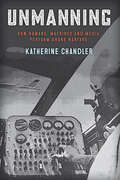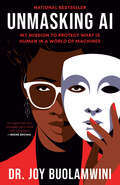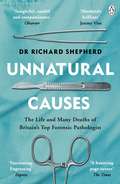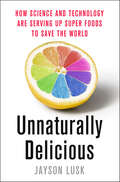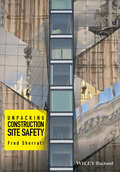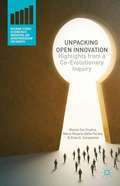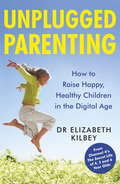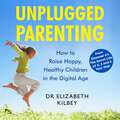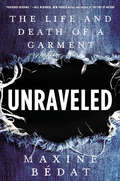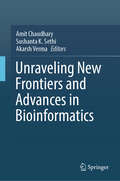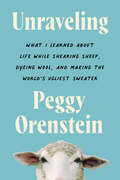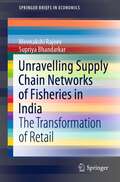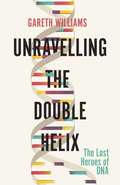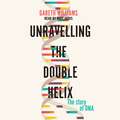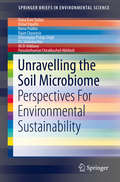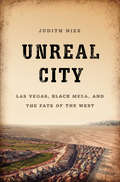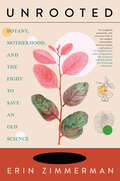- Table View
- List View
Unmanned Aircraft Systems
by Manoj Kumar Anand Nayyar Sachin Kumar Gupta Shubham MahajanThis book is an essential resource for anyone looking to understand the cutting-edge applications and evolving technologies of Unmanned Aerial Systems, showcasing how they enhance safety and efficiency in monitoring, emergency response, and smart city development. With the evolution of Unmanned Aircraft Systems (UAS), its applications can be observed in the fields of monitoring for fire detection, sustainable computing, emergencies, and law enforcement. They can be useful for monitoring or screening applications, as well as the deployment of smart cities, security monitoring, and communication establishments at rare locations or unapproachable locations. Thus, the wireless ad-hoc networks of Unmanned Aerial Vehicles (UAVs) and infrastructure-based UAVs can be utilized in this proposal. Unmanned aircraft systems (UAS) extend human potential and allow us to execute dangerous or difficult tasks safely and efficiently, saving time, money, and, most importantly, lives. UAS can help police, fire, and other public workers save lives in emergencies like natural disasters, locate missing animals and children, or help fight fighters. Unmanned Aircraft Systems contains novel contributions and emerging trends in the area of Unmanned Aerial Vehicles (UAV), drones, and aircraft without a human pilot aboard. It has three segments incorporating technological advancements and future trends in UAS, the policies and security aspects of UAVs, and their applications as an intelligent system. Along with these state-of-the-art techniques, this book also incorporates advances in AI and machine learning, deep learning, IoT technology, cybersecurity and Blockchain, UAV regulation policies in the United States and Europe, SOTA in ITS, and many more technological advancements, which makes this book the pioneer and benchmarking reference in these areas.
Unmanned Aircraft Systems
by Reg AustinUnmanned Aircraft Systems delivers a much needed introduction to UAV System technology, taking an integrated approach that avoids compartmentalising the subject. Arranged in four sections, parts 1-3 examine the way in which various engineering disciplines affect the design, development and deployment of UAS. The fourth section assesses the future challenges and opportunities of UAS.Technological innovation and increasingly diverse applications are two key drivers of the rapid expansion of UAS technology. The global defence budget for UAS procurement is expanding, and in the future the market for civilian UAVs is expected to outmatch that of the military. Agriculture, meteorology, conservation and border control are just a few of the diverse areas in which UAVs are making a significant impact; the author addresses all of these applications, looking at the roles and technology behind both fixed wing and rotorcraft UAVs.Leading aeronautical consultant Reg Austin co-founded the Bristol International Remotely Piloted Vehicle (RPV) conferences in 1979, which are now the longest-established UAS conferences worldwide. In addition, Austin has over 40 years' experience in the design and development of UAS. One of Austin's programmes, the "Sprite UAV System" has been deployed around the world and operated by day and night, in all weathers.
Unmanned Aircraft Systems
by Wei Shyy Richard BlockleyCovering the design, development, operation and mission profiles of unmanned aircraft systems, this single, comprehensive volume forms a complete, stand-alone reference on the topic. The volume integrates with the online Wiley Encyclopedia of Aerospace Engineering, providing many new and updated articles for existing subscribers to that work.
Unmanned Aircraft Systems Traffic Management: UTM
by Michael S. BaumThis book introduces unmanned aircraft systems traffic management (UTM) and how this new paradigm in traffic management integrates unmanned aircraft operations into national airspace systems. Exploring how UTM is expected to operate, including possible architectures for UTM implementations, and UTM services, including flight planning, strategic coordination, and conformance monitoring, Unmanned Aircraft Systems Traffic Management: UTM considers the boundaries of UTM and how it is expected to interlace with tactical coordination systems to maintain airspace safety. The book also presents the work of the global ecosystem of players advancing UTM, including relevant standards development organizations (SDOs), and considers UTM governance paradigms and challenges. FEATURES Describes UTM concept of operations (ConOps) and global variations in architectures Explores envisioned UTM services, including flight planning, strategic coordination, conformance monitoring, contingency management, constraints and geo-awareness, and remote identification Highlights cybersecurity standards development and awareness Covers approaches to the approval, management, and oversight of UTM components and ecosystem Considers the future of UTM and potential barriers to its success, international coordination, and regulatory reform This book is an essential, in-depth, annotated resource for developers, unmanned aircraft system operators, pilots, policy makers, researchers, and academics engaged in unmanned systems, transportation management, and the future of aviation.
Unmanned Rotorcraft Systems
by Guowei Cai Tong Heng Lee Ben M. ChenUnmanned Rotorcraft Systems explores the research and development of fully-functional miniature UAV (unmanned aerial vehicle) rotorcraft, and provides a complete treatment of the design of autonomous miniature rotorcraft UAVs. The unmanned system is an integration of advanced technologies developed in communications, computing, and control areas, and is an excellent testing ground for trialing and implementing modern control techniques. Included are detailed expositions of systematic hardware construction, software systems integration, aerodynamic modeling; and automatic flight control system design. Emphasis is placed on the cooperative control and flight formation of multiple UAVs, vision-based ground target tracking, and landing on moving platforms. Other issues such as the development of GPS-less indoor micro aerial vehicles and vision-based navigation are also discussed in depth: utilizing the vision-based system for accomplishing ground target tracking, attacking and landing, cooperative control and flight formation of multiple unmanned rotorcraft; and future research directions on the related areas.
Unmanned and Autonomous Ships: An Overview of MASS
by R. Glenn WrightUnmanned ships and autonomous ships are quickly becoming a reality, making shipping safer and more efficient. However, traditional tasks and functions are becoming blurred as new technology changes how the unique needs of different sectors are met. In addition to large vessels dedicated to the transport of goods and cargos across the oceans, major efforts are underway towards the automation of small coastal shipping that includes ferries, tugboats, supply and service vessels, and barges. Automated vehicles are also replacing conventional ships for inspecting and servicing pipelines, drilling platforms, wind farms and other offshore installations. Automated shipping is explored in terms of economics, technology, safety and the environment under the broad themes of ship design and engineering, command and control, navigation, communications, security, regulatory issues, and training. This includes initiatives for autonomous shipping as well as civilian implications of military ship automation programs. This book is primarily for maritime professionals, regulatory authorities, insurers, and environmental groups. It also suits undergraduate students involved in deck officer training, and graduate students and academics involved in research in ship design, operations and management.
Unmanned: Drone Warfare and Global Security
by John Hill Ann RogersDrones have become the controversial new weapon of choice for the US military abroad. Unmanned details the causes and deadly consequences of this terrifying new development in warfare, and explores the implications for international law and global peace. Ann Rogers and John Hill argue that drones represent the first truly globalized technology of war. The book shows how unmanned systems are changing not simply how wars are fought, but the meaning of conflict itself. Providing an unparalleled account of new forms of twenty-first century imperial warfare, Unmanned shows how drone systems dissolve the conventional obstacles of time and space that have traditionally shaped conflict in the international system. It considers the possibility that these weapons will become normalized in global conflict, raising the spectre of new, unpredictable, and unaccountable forms of warfare.
Unmanning: How Humans, Machines and Media Perform Drone Warfare (War Culture)
by Katherine ChandlerUnmanning studies the conditions that create unmanned platforms in the United States through a genealogy of experimental, pilotless planes flown between 1936 and 1992. Characteristics often attributed to the drone—including machine-like control, enmity and remoteness—are achieved by displacements between humans and machines that shape a mediated theater of war. Rather than primarily treating the drone as a result of the war on terror, this book examines contemporary targeted killing through a series of failed experiments to develop unmanned flight in the twentieth century. The human, machine and media parts of drone aircraft are organized to make an ostensibly not human framework for war that disavows its political underpinnings as technological advance. These experiments are tied to histories of global control, cybernetics, racism and colonialism. Drone crashes and failures call attention to the significance of human action in making technopolitics that comes to be opposed to “man” and the paradoxes at their basis.
Unmasking AI: My Mission to Protect What Is Human in a World of Machines
by Joy BuolamwiniNATIONAL BESTSELLER • &“The conscience of the AI revolution&” (Fortune) explains how we&’ve arrived at an era of AI harms and oppression, and what we can do to avoid its pitfalls.&“AI is not coming, it&’s here. If we answer the beautiful call inside these pages, we can decide who we are going to be and how we&’re going to use technology in service of what it means to be fully human.&”—Brené Brown, #1 New York Times bestselling author of Dare to Lead A LOS ANGELES TIMES BEST BOOK OF THE YEAR • Shortlisted for the Inc. Non-Obvious Book AwardTo most of us, it seems like recent developments in artificial intelligence emerged out of nowhere to pose unprecedented threats to humankind. But to Dr. Joy Buolamwini, who has been at the forefront of AI research, this moment has been a long time in the making.After tinkering with robotics as a high school student in Memphis and then developing mobile apps in Zambia as a Fulbright fellow, Buolamwini followed her lifelong passion for computer science, engineering, and art to MIT in 2015. As a graduate student at the &“Future Factory,&” she did groundbreaking research that exposed widespread racial and gender bias in AI services from tech giants across the world.Unmasking AI goes beyond the headlines about existential risks produced by Big Tech. It is the remarkable story of how Buolamwini uncovered what she calls &“the coded gaze&”—the evidence of encoded discrimination and exclusion in tech products—and how she galvanized the movement to prevent AI harms by founding the Algorithmic Justice League. Applying an intersectional lens to both the tech industry and the research sector, she shows how racism, sexism, colorism, and ableism can overlap and render broad swaths of humanity &“excoded&” and therefore vulnerable in a world rapidly adopting AI tools. Computers, she reminds us, are reflections of both the aspirations and the limitations of the people who create them.Encouraging experts and non-experts alike to join this fight, Buolamwini writes, &“The rising frontier for civil rights will require algorithmic justice. AI should be for the people and by the people, not just the privileged few.&”
Unnatural Causes: 'An absolutely brilliant book. I really recommend it, I don't often say that' Jeremy Vine, BBC Radio 2
by Dr Richard ShepherdTHE TRUE CRIME BOOK OF THE YEAR AND 18-WEEK SUNDAY TIMES TOP 10 BESTSELLER'One of the most fascinating books I have read in a long time. Engrossing, a haunting page-turner. A book I could not put down' The Times, BOOKS OF THE YEAR__________Meet the forensic pathologist, Dr Richard Shepherd.He solves the mysteries of unexplained or sudden death.He has performed over 23,000 autopsies, including some of the most high-profile cases of recent times; the Hungerford Massacre, the Princess Diana inquiry, and 9/11. He has faced serial killers, natural disaster, 'perfect murders' and freak accidents.His evidence has put killers behind bars, freed the innocent, and turned open-and-shut cases on their heads. Yet all this has come at a huge personal cost. Unnatural Causes tells the story of not only the cases and bodies that have haunted him the most, but also how to live a life steeped in death. Thoughtful, revealing, chilling and always unputdownable, if you liked All That Remains, War Doctor and This is Going to Hurt you'll love this. **Pre-order Dr Richard Shepherd's new book THE SEVEN AGES OF DEATH now**__________'Gripping, grimly fascinating, and I suspect I'll read it at least twice' Evening Standard'A deeply mesmerising memoir of forensic pathology. Human and fascinating' Nigella Lawson 'An absolutely brilliant book. I really recommend it, I don't often say that but it's fascinating' Jeremy Vine, BBC Radio 2'Puts the reader at his elbow as he wields the scalpel' Guardian 'Fascinating, gruesome yet engrossing' Richard and Judy, Daily Express'Fascinating, insightful, candid, compassionate' Observer
Unnaturally Delicious: How Science and Technology Are Serving Up Super Foods to Save the World
by Jayson LuskThe food discussion in America can be quite pessimistic. With high obesity rates, diabetes, climate change, chemical use, water contamination, and farm animal abuse, it would seem that there wasn't very much room for a positive perspective. The fear that there just isn't enough food has expanded to new areas of concern about water availability, rising health care costs, and dying bees.In Unnaturally Delicious, Lusk makes room for optimism by writing the story of the changing food system, suggesting that technology and agriculture can work together in a healthy and innovative way to help solve the world's largest food issues and improve the farming system as we know it.This is the story of the innovators and innovations shaping the future of food. You’ll meet an ex-farmer entrepreneur whose software is now being used all over the world to help farmers increase yields and reduce nutrient runoff and egg producers who’ve created new hen housing systems that improve animal welfare at an affordable price. There are scientists growing meat in the lab. Without the cow. College students are coaxing bacteria to signal food quality and fight obesity. Nutrient enhanced rice and sweet potatoes are aiming to solve malnutrition in the developing world. Geneticists are creating new wheat varieties that allow farmers sustainably grow more with less. And, we’ll learn how to get fresh, tasty, 3D printed food at the touch of a button, perhaps even delivered to us by a robotic chef. Innovation is the American way. Thomas Jefferson, George Washington Carver, and John Harvey Kellogg were food and agricultural entrepreneurs. Their delicious innovations led to new healthy, tasty, convenient, and environmentally friendly food. The creations were unnaturally delicious. Unnatural because the foods and practices they fashioned were man-made solutions to natural and man-made problems. Now the world is filled with new challenges changing the way we think about food. Who are the scientists, entrepreneurs, and progressive farmers who meet these challenges and search for solutions? Unnaturally Delicious has the answers.
Unpacking Construction Site Safety
by Fred SherrattUnpacking Construction Site Safety provides a different perspective of safety in practice. ? examines how useful the concept of safety actually is to the development of effective management interventions ? providing new insights and information to the audience, and assist in a more informed development of new approaches in practice ? aimed at safety and construction management practitioners as well as academics
Unpacking Open Innovation
by Maria Rosaria Della Peruta Manlio Del Giudice Elias G. CarayannisDisintegrated or distributed innovation, collaborative innovation, collective invention, collegial innovation, free innovation, open knowledge disclosure, free knowledge disclosure: are these all the same thing? This shows us there is some confusion regarding open innovation, or at least there is a need to cast a wider net around what open innovation is all about. The prevailing thought is that open innovation allows organizations to simultaneously expand their breadth of ideas, opportunities, and know-how while minimizing the technical and market risks associated with innovation. As a result, open innovation appears to come with little down side. Del Giudice, Della Peruta, and Carayannis fill the gap in our understanding of this emerging research field of open innovation. Their work depicts the major tendencies of publications through identifying the main themes in literature and investigating the research frontier. It also discusses potentially important fields of investigation that are still left rather unexplored.
Unplugged Parenting: How to Raise Happy, Healthy Children in the Digital Age
by Dr Elizabeth KilbeyThe book that every parent needs. Written by the expert child psychologist, Dr Elizabeth Kilbey, from Channel 4's The Secret Life of 4, 5 and 6 Year Olds. 'Children who get too much screen time are at risk of anxiety disorders' - BBC NewsThis is the book that every parent with a child under the age of 11 (in the latency stage of brain development) needs in order to navigate the tricky pathway of how much screen time to allow on a daily basis. Play has gone from a physical, creative experience using toys and imagination to something that now involves sitting down alone for hours at a time. Parents are dealing with children who don't listen to them, who are unable to concentrate for very long, who refuse to do homework and who constantly battle against them for more screen time. In this book, Dr Elizabeth Kilbey will offer tangible, practical advice about how to 'unplug' your child from their device so their online time doesn't become all-consuming and how we, as parents, can plug in to connect with our children.
Unplugged Parenting: How to Raise Happy, Healthy Children in the Digital Age
by Dr Elizabeth KilbeyThe book that every parent needs. Written by the expert child psychologist, Dr Elizabeth Kilbey, from Channel 4's The Secret Life of 4, 5 and 6 Year Olds. 'Children who get too much screen time are at risk of anxiety disorders' - BBC NewsThis is the book that every parent with a child under the age of 11 (in the latency stage of brain development) needs in order to navigate the tricky pathway of how much screen time to allow on a daily basis. Play has gone from a physical, creative experience using toys and imagination to something that now involves sitting down alone for hours at a time. Parents are dealing with children who don't listen to them, who are unable to concentrate for very long, who refuse to do homework and who constantly battle against them for more screen time. In this book, Dr Elizabeth Kilbey will offer tangible, practical advice about how to 'unplug' your child from their device so their online time doesn't become all-consuming and how we, as parents, can plug in to connect with our children.(P)2017 Headline Publishing Group Ltd
Unraveled: The Life and Death of a Garment
by Maxine BedatA groundbreaking chronicle of the birth--and death--of a pair of jeans, that exposes the fractures in our global supply chains, and our relationships to each other, ourselves, and the planetTake a look at your favorite pair of jeans. Maybe you bought them on Amazon or the Gap; maybe the tag says "Made in Bangladesh" or "Made in Sri Lanka." But do you know where they really came from, how many thousands of miles they crossed, or the number of hands who picked, spun, wove, dyed, packaged, shipped, and sold them to get to you? The fashion industry operates with radical opacity, and it's only getting worse to disguise countless environmental and labor abuses. It epitomizes the ravages inherent in the global economy, and all in the name of ensuring that we keep buying more while thinking less about its real cost. In Unraveled, entrepreneur, researcher, and advocate Maxine Bédat follows the life of an American icon--a pair of jeans--to reveal what really happens to give us our clothes. We visit a Texas cotton farm figuring out how to thrive without relying on fertilizers that poison the earth. Inside dyeing and weaving factories in China, where chemicals that are banned in the West slosh on factory floors and drain into waterways used to irrigate local family farms. Sewing floors in Bangladesh and Sri Lanka are crammed with women working for illegally low wages to produce garments as efficiently as machines. Back in America, our jeans get stowed, picked, and shipped out by Amazon warehouse workers pressed to be as quick as the robots primed to replace them. Finally, those jeans we had to have get sent to landfills--or, if they've been "donated," shipped back around the world to Africa, where they're sold for pennies in secondhand markets or buried and burned in mountains of garbage. A sprawling, deeply researched, and provocative tour-de-force, Unraveled is not just the story of a pair of pants, but also the story of our global economy and our role in it. Told with piercing insight and unprecedented reporting, Unraveled challenges us to use our relationship with our jeans--and all that we wear--to reclaim our central role as citizens to refashion a society in which all people can thrive and preserve the planet for generations to come.
Unraveling New Frontiers and Advances in Bioinformatics
by Akarsh Verma Sushanta K. Sethi Amit ChaudharyThis book describes the bioinformatics research field, from its historical roots to the cutting-edge technologies. Many readers can discover the power of next-generation sequencing and genomic data analysis, uncover the secrets of single-cell genomics and transcriptomics, explore the metagenomics and microbiome analysis, and predict the protein structures using structural bioinformatics. Several case studies witnessing the fusion of bioinformatics and artificial intelligence, driving insights from vast biological datasets have also been explored. Other important aspects listed in the book are integrating the omics data for a holistic view of biological systems; experiencing the future of medicine with precision healthcare and personalized treatments; accelerating drug discovery and repurposing through computational approaches; agricultural genomics; and exploring the role of immunoinformatics in designing effective vaccines against infectious diseases.
Unraveling: What I Learned About Life While Shearing Sheep, Dyeing Wool, and Making the World's Ugliest Sweater
by Peggy Orenstein“Orenstein is such a breezy, funny writer, it’s easy to forget she’s an important thinker too.”—PeopleIn this lively, funny memoir, Peggy Orenstein sets out to make a sweater from scratch—shearing, spinning, dyeing wool—and in the process discovers how we find our deepest selves through craft. Orenstein spins a yarn that will appeal to everyone. The COVID pandemic propelled many people to change their lives in ways large and small. Some adopted puppies. Others stress-baked. Peggy Orenstein, a lifelong knitter, went just a little further. To keep herself engaged and cope with a series of seismic shifts in family life, she set out to make a garment from the ground up: learning to shear sheep, spin and dye yarn, then knitting herself a sweater.Orenstein hoped the project would help her process not just wool but her grief over the recent death of her mother and the decline of her dad, the impending departure of her college-bound daughter, and other thorny issues of aging as a woman in a culture that by turns ignores and disdains them. What she didn’t expect was a journey into some of the major issues of our time: climate anxiety, racial justice, women’s rights, the impact of technology, sustainability, and, ultimately, the meaning of home.With her wry voice, sharp intelligence, and exuberant honesty, Orenstein shares her year-long journey as daughter, wife, mother, writer, and maker—and teaches us all something about creativity and connection.
Unravelling Supply Chain Networks of Fisheries in India: The Transformation of Retail (SpringerBriefs in Economics)
by Meenakshi Rajeev Supriya BhandarkarThis book on the fisheries sector in India, through primary surveys as well as secondary literature, brings out various nuances of the sector and its trade opportunities, the complexities surrounding the supply chain of fish, as well as the evolution of its marketing channels. A distinctive feature of this book is that it carries out a comprehensive mapping of the fisheries supply chain, by taking into account both marine and freshwater fish. It identifies various players, especially traders who take part in the product flow, irrespective of the impact each of them has on the value provided to the end customer. While members of the supply chain include all individuals or organisations between whom interaction takes place, directly or indirectly from the point of production to consumption, this study also distinguishes between primary and peripheral members to make a complex network more manageable. Moreover, the book provides a comprehensive analysis of the emerging marketing channels- both organised and unorganised- in this highly perishable food segment. It provides important insights into the current scenario, focusing on the emergence of newer forms of marketing such as multinationals and e-retailing, while highlighting how traditional forms such as ‘mom-and-pop’ shops have continued to sustain, despite the challenges they face. The findings from India are also compared to global experiences of other fish producing and exporting countries such as Bangladesh, Indonesia, and Thailand to offer a comparison of the differences and similarities in the supply chains of various countries. The book provides important takeaways for researchers and PhD scholars working in the area of fisheries as well as supply chains. Since this book is based on field visits to different parts of the country it brings out the ground realities along with interesting insights and important policy implications for the sector, and should, therefore, appeal to policymakers as well.
Unravelling the Double Helix: The Lost Heroes of DNA
by Gareth WilliamsDNA. The double helix; the blueprint of life; and, during the early 1950s, a baffling enigma that could win a Nobel Prize. Everyone knows that James Watson and Francis Crick discovered the double helix. In fact, they clicked into place the last piece of a huge jigsaw puzzle that other researchers had assembled over decades. Researchers like Maurice Wilkins (the 'Third Man of DNA') and Rosalind Franklin, famously demonised by Watson. Not forgetting the 'lost heroes' who fought to prove that DNA is the stuff of genes, only to be airbrushed out of history. In Unravelling the Double Helix, Professor Gareth Williams sets the record straight. He tells the story of DNA in the round, from its discovery in pus-soaked bandages in 1868 to the aftermath of Watson's best-seller The Double Helix a century later. You don't need to be a scientist to enjoy this book. It's a page-turner that unfolds like a detective story, with suspense, false leads and treachery, and a fabulous cast of noble heroes and back-stabbing villains. But beware: some of the science is dreadful, and the heroes and villains may not be the ones you expect.
Unravelling the Double Helix: The Lost Heroes of DNA
by Gareth WilliamsDNA. The double helix; the blueprint of life; and, during the early 1950s, a baffling enigma that could win a Nobel Prize. Everyone knows that James Watson and Francis Crick discovered the double helix. In fact, they clicked into place the last piece of a huge jigsaw puzzle that other researchers had assembled over decades. Researchers like Maurice Wilkins (the 'Third Man of DNA') and Rosalind Franklin, famously demonised by Watson. Not forgetting the 'lost heroes' who fought to prove that DNA is the stuff of genes, only to be airbrushed out of history. In Unravelling the Double Helix, Professor Gareth Williams sets the record straight. He tells the story of DNA in the round, from its discovery in pus-soaked bandages in 1868 to the aftermath of Watson's best-seller The Double Helix a century later. You don't need to be a scientist to enjoy this book. It's a page-turner that unfolds like a detective story, with suspense, false leads and treachery, and a fabulous cast of noble heroes and back-stabbing villains. But beware: some of the science is dreadful, and the heroes and villains may not be the ones you expect.
Unravelling the Double Helix: The Lost Heroes of DNA
by Gareth WilliamsDNA. The double helix; the blueprint of life; and, during the early 1950s, a baffling enigma that could win a Nobel Prize. Everyone knows that James Watson and Francis Crick discovered the double helix. In fact, they clicked into place the last piece of a huge jigsaw puzzle that other researchers had assembled over decades. Researchers like Maurice Wilkins (the 'Third Man of DNA') and Rosalind Franklin, famously demonised by Watson. Not forgetting the 'lost heroes' who fought to prove that DNA is the stuff of genes, only to be airbrushed out of history. In Unravelling the Double Helix, Professor Gareth Williams sets the record straight. He tells the story of DNA in the round, from its discovery in pus-soaked bandages in 1868 to the aftermath of Watson's best-seller The Double Helix a century later. You don't need to be a scientist to enjoy this book. It's a page-turner that unfolds like a detective story, with suspense, false leads and treachery, and a fabulous cast of noble heroes and back-stabbing villains. But beware: some of the science is dreadful, and the heroes and villains may not be the ones you expect.
Unravelling the Soil Microbiome: Perspectives For Environmental Sustainability (SpringerBriefs in Environmental Science)
by Dhananjaya Pratap Singh Ratna Prabha Purushothaman Chirakkuzhyil Abhilash Rama Kant Dubey Vishal Tripathi Rajan Chaurasia Ch. Srinivasa Rao Ali El-KeblawyThis book explores the significance of soil microbial diversity to understand its utility in soil functions, ecosystem services, environmental sustainability, and achieving the sustainable development goals. With a focus on agriculture and environment, the book highlights the importance of the microbial world by providing state-of-the-art technologies for examining the structural and functional attributes of soil microbial diversity for applications in healthcare, industrial biotechnology, and bioremediation studies. In seven chapters, the book will act as a primer for students, environmental biotechnologists, microbial ecologists, plant scientists, and agricultural microbiologists. Chapter 1 introduces readers to the soil microbiome, and chapter 2 discusses the below ground microbial world. Chapter 3 addresses various methods for exploring microbial diversity, chapter 4 discusses the genomics methods, chapter 5 provides the metaproteomics and metatranscriptomics approaches and chapter 6 details the bioinformatics tools for soil microbial community analysis, and chapter 7 concludes the text with future perspectives on further soil microbial uses and applications.
Unreal City: Las Vegas, Black Mesa, and the Fate of the West
by Judith NiesAn epic struggle over land, water, and power is erupting in the American West and the halls of Washington, DC. It began when a 4,000-square-mile area of Arizona desert called Black Mesa was divided between the Hopi and Navajo tribes. To the outside world, it was a land struggle between two fractious Indian tribes; to political insiders and energy corporations, it was a divide-and-conquer play for the 21 billion tons of coal beneath Black Mesa. Today, that coal powers cheap electricity for Los Angeles, a new water aqueduct into Phoenix, and the neon dazzle of Las Vegas. Journalist and historian Judith Nies has been tracking this story for nearly four decades. She follows the money and tells us the true story of wealth and water, mendacity, and corruption at the highest levels of business and government. Amid the backdrop of the breathtaking desert landscape, Unreal City shows five cultures colliding-Hopi, Navajo, global energy corporations, Mormons, and US government agencies-resulting in a battle over resources and the future of the West. Las Vegas may attract 39 million visitors a year, but the tourists mesmerized by the dancing water fountains at the Bellagio don’t ask where the water comes from. They don’t see a city with the nation’s highest rates of foreclosure, unemployment, and suicide. They don’t see the astonishing drop in the water level of Lake Mead-where Sin City gets 90 percent of its water supply. Nies shows how the struggle over Black Mesa lands is an example of a global phenomenon in which giant transnational corporations have the power to separate indigenous people from their energy-rich lands with the help of host governments. Unreal City explores how and why resources have been taken from native lands, what it means in an era of climate change, and why, in this city divorced from nature, the only thing more powerful than money is water.
Unrooted: Botany, Motherhood, and the Fight to Save an Old Science
by Erin Zimmerman"Evolutionary botanist Zimmerman discusses her passion for plants and inveighs against sexism in the sciences in her marvelous debut memoir...Throughout, Zimmerman&’s enthusiasm and expertise make the science accessible even to those without a background in the subject. The results are as edifying as they are galvanizing." - Publishers Weekly STARRED Review"Erin Zimmerman has exposed a rooted gender failure in science. Her book is important not for this alone. Her work is essential for understanding the future resilience of all flora on this planet." -Diana Beresford-Kroeger, author of To Speak for the TreesAn exploration of science, motherhood, and academia, and a stirring account of a woman at a personal and professional crossroads . . .Growing up in rural Ontario, Erin Zimmerman became fascinated with plants—an obsession that led to a life in academia as a professional botanist. But as her career choices narrowed in the face of failing institutions and subtle, but ubiquitous, sexism, Zimmerman began to doubt herself.Unrooted: Botany, Motherhood, and the Fight to Save an Old Science is a scientist&’s memoir, a glimpse into the ordinary life of someone in a fascinating field. This is a memoir about plants, about looking at the world with wonder, and about what it means to be a woman in academia—an environment that pushes out mothers and those with any outside responsibilities. Zimmerman delves into her experiences as a new mom, her decision to leave her position in post-graduate research, and how she found a new way to stay in the field she loves.She also explores botany as a &“dying science&” worth fighting for. While still an undergrad, Zimmerman&’s university started the process of closing the Botany Department, a sign of waning funding for her beloved science. Still, she argues for its continuation, not only because we have at least 100,000 plant species yet to be discovered, but because an understanding of botany is crucial in the fight against climate change and biodiversity loss.Zimmerman is also a botanical illustrator and will provide 8 original illustrations for the book.
